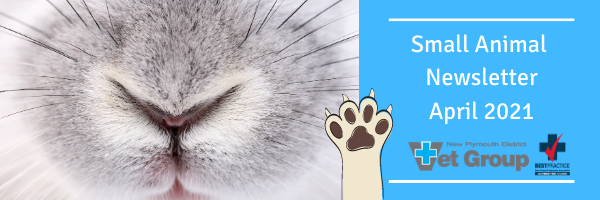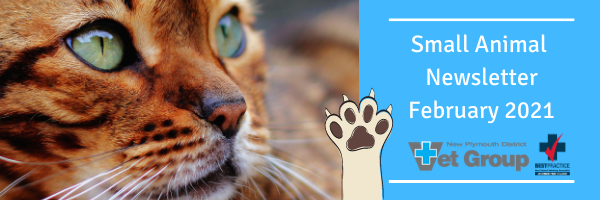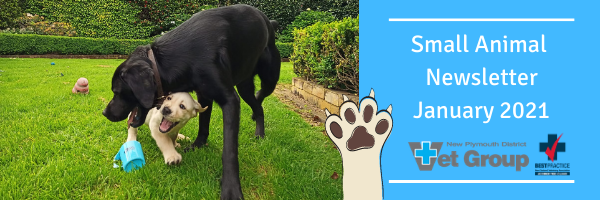We now offer Low Level Laser Therapy (LLLT also known as Photobiomodulation) Recently, we started offering…

Small Animal Newsletter July 2019
August is ‘Dental Awareness Month’

Dental care is an important part of maintaining the wellbeing of your pet. During the month of August, we will be offering our annual FREE NURSE DENTAL CHECKS at both New Plymouth Vet Group and St Aubyn Veterinary Clinic until 30th August 2019. Contact one of our clinics to make your booking today. (Bookings are essential).
New Plymouth Vet Group – (06) 758 4006 or St Aubyn Veterinary Clinic – (06) 751 3000
Are bones safe for dogs? Written by Dr Ross Gadsby
In the last few weeks, our clinic has seen multiple dogs with issues resulting from feeding bones intentionally or unintentionally. “Coopers” owners has kindly allowed us to share his story. Cooper presented to our clinic having been constipated for 3 days.
At that stage, his gut was still working and he could pass small amounts of watery faeces around the obstruction in his rectum. The blockage was caused by the bony shards setting like “concrete ”.This happens as the large bowel removes water from the faeces before the stool is passed.
He was admitted and in spite of multiple enemas, the following day his gut stopped contracting (called illeus) as a result of his obstruction.
Unfortunately, we had to give Cooper a general anaesthetic so we could manually “depoo” him via his rectum. That removed the first obstruction but as you can see the second one was approaching also. The next day his gut started contracting again and with multiple enemas, he passed the remaining shards over a few days.
It does not take a lot of imagination to have some idea what Cooper was going through. As a patient, Cooper was extremely obliging throughout his ordeal!
It does not take a lot of imagination to have some idea what Cooper was going through. As a patient, Cooper was extremely obliging throughout his ordeal!
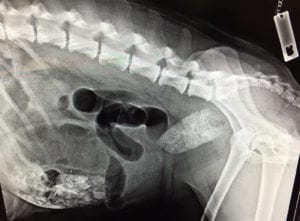
We as vets are biased as we only see the problems that bones can cause so, what are the perils?
Bones can fracture and break teeth!
- Some bones especially hard beef bones (femur/humerus/cannon/shin) can fracture and break teeth, especially the large grinding carnassial teeth at the back of the mouth. When a dog crushes a bone it can also wedge inside the dog’s mouth. They often wedge transversely between the teeth on the left and those on the right side of the mouth or they can lodge over a molar tooth where they become stuck like a bulldog clip. This causes excessive drooling and can cause extensive damage to the teeth and mouth if left unnoticed. This is more likely with short pieces of bone.
Bone marrow can cause digestive upsets
- Bone marrow contains a high percentage of fat which can cause digestive upsets in some dogs eg diarrhoea, vomiting or even potentially life-threatening conditions such as pancreatitis (inflammation of the pancreas). This high-fat content can also lead to obesity. If you feed your dog a bone you will need to walk them for longer or only fed them a portion of their dinner that day.
Bones can cause constipation
- Constipation is often caused by feeding excess amounts of bone to a dog. The bone fragments, which don’t absorb water, tend to concrete the dog’s faeces together and the resultant lumps are so hard that they cannot be passed. This problem is especially common with Bull Terriers, Staffordshire Bull Terriers or similar breeds with powerful jaws, as they are easily able to crush a whole bone and consume it in a matter of seconds, where a dog with a less powerful jaw will take several days.
- It is not difficult to tell whether your dog is coping with the bones you are giving him. Examine his stools over the next few days and if he has difficulty in passing his motions, if his motions are excessively hard and dry, or if they contain visible fragments of bone, then he consumes the bone too quickly and does not chew them sufficiently. In this case, either eliminate bones from his diet, or give him bones much less frequently and when you do, give a smaller quantity and select bones that are a softer type (eg brisket bones). Also, some dogs having consumed bones their whole life with no problems, can start having problems as they get older as their large bowel works less efficiently.
- Small sharp pieces of bone may splinter and perforate the intestines, causing death or the need for life-threatening surgery.
Bones can cause obstructions
- I have also seen numerous dogs that have swallowed large pieces of bones that have obstructed in the small intestine necessitating surgery to remove them.
Swallowing large pieces of knucklebones can get lodged in the throat
- We have also have had dogs die from swallowing large pieces of knucklebones which lodged in the larynx and caused asphyxiation and death. This seems more common in the short nose breeds eg boxers.
IN SUMMARY
In summary, I know millions of dogs eat bones regularly with no complications, but you must judge for yourself. If your dogs just gnaws and nibbles at bones it may be fine – however, if you have a dog with a powerful jaw which tends to break up and eat whole bones rapidly or in large pieces I would definitely advise you not to feed bones!
Watch out for WORMS! Out of sight, out of mind?

Worms can also spend a lot of their lifecycle as eggs in the environment… canine whipworm eggs can even live for up to 5 years in the soil! So protection relies on routine treatment as the threat of re-infection from the environment is always present.

That said, many untreated adult pets have low adult worm burdens but are continually shedding microscopic eggs into the environment, which in turn infect other animals, and some can cause serious illness in other pets and even humans. Children who are often closest to family pets, and love to cuddle and kiss and be licked on the face by their pets, are most at risk from developing a condition that can cause blindness, ‘ocular larval migrans’. Unfortunately, worm eggs and larvae can be swallowed in the process of just being friendly. Another good reason for taking proactive action and worming your pet regularly.
Tips to keep worms away
- Make sure all pets are getting wormed regularly – usually every 3 months.
- Clean kennels and sleeping areas regularly. Remove faeces from the environment and cat litter trays. They poop – you scoop!
- Cover play-area sandpits so pets don’t use them as a toilet.
- As Flea Tapeworm larvae develops inside fleas, control fleas on your pets all year round.
- Avoid feeding untreated raw meat or offal. Feed a good quality wet or dry diet.
- Prevent pets from eating the intermediate hosts of worms for example slugs, rodents and birds. Controlling rats and mice with traps might help.
- Wash your hands after playing with your pet and avoid pets licking your face.
- Ask us about joining our ‘repeat ordering service for flea and worm treatments’ and get products delivered to your door!
Preventing Grass Seeds
Written by Vet Nurse Paige Miller
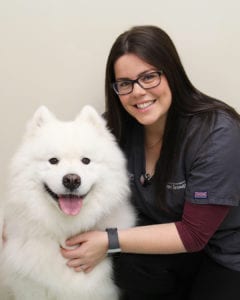
Grass seed’s account for a surprisingly large portion of veterinary consults and surgeries over the spring and summer months. It is hard to think these tiny things can be such a huge problem, but I have lost count of the number of dogs we have surgically removed grass seeds from this year alone! These nasty little awns have a pointed end and arrow-shaped fibres so they can easily become embedded in pet’s skin and are only able to move forward; tracking infection as they quickly burrow through the body.
I first assumed that grass seeds were typically a long hair dog problem, having a fluffy Samoyed who loves to play in long grass and collect as many as he can in a day. Luckily for us, I always managed to find and extract them before they fully entered his body and became a much larger issue. Since becoming a vet nurse and working in a clinic, I have now seen numerous animal’s need grass seeds removed as they have burrowed so deep into the poor dog. As the body cannot generally break down the grass seed, and antibiotics will only temporarily tackle the infection, it will continue to cause havoc until it is removed.
The grass seeds typically fall off long grass and embed themselves in dog’s paws, ears, armpits, tail, groin, or even face and eyes as dogs rub their faces in the long grass.
This can cause painful wounds, swelling, and infection, and an unsuspecting owner may not realise the full extent of the issue.
What to look for…
- Hair matting with a scab/small wound underneath
- Licking / chewing at one area
- Limping, or an area that is painful to touch
- Irritation, swelling, or a lump possibly with blood, pus, or an awn sticking out
- Sore red ears or shaking of head
- Red, weepy eye
- Sneezing and pawing at nose
- Blood or difficulty toileting if embedded in/around genitals
Prevention is the best cure!
- Where possible, avoid long grassy areas in the warmer months, and keep lawns short
- Keep long-haired dogs trimmed/clipped, especially around their feet and in between their toes
- Thoroughly check your pet each day, especially after walks! Have a good look and feel over them, and check inside ears, and in between toes
- If you see a grass seed, use tweezers to remove this immediately, then keep a close eye on the area for further irritation or infection
- If you cannot remove the grass seed, or suspect one is burrowed under the skin, call your vet immediately!
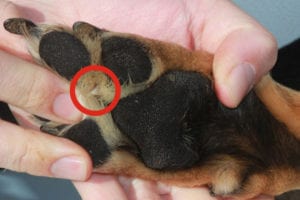
We now offer ‘Oxipay’ as a payment option. 4 easy payments with no interest. To find out more or to sign up visit the Oxipay website here. Other accepted methods include Cash, Credit Card, Q Card, Q Mastercard and Farmers Card. We also are a Vet Care Finance partner and you can find out more information about them here.
Staff Showcase – Vet Nurse Shannon McClay

Our Instagram Superstar
Meet ‘Nemotoad Baked Bean’! He is a 5-year-old year Staffy cross. He had been staying with us for a wee while and was enjoying some tummy rubs from the nurses when we got this cool snap.
Have you checked out our Instagram page yet? Updated daily – Meet our pet visitors and patients! Click here!
Disclaimer: This email contains comments of a general nature only and is not intended to be a substitute for professional veterinary advice.





